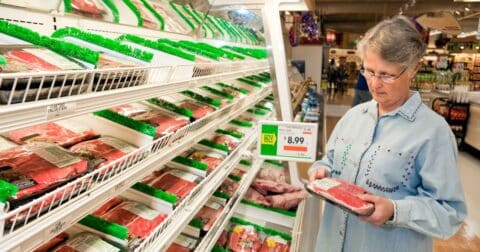News
More Than 71% of Americans Oppose Common Factory Farming Practices
Factory Farms•5 min read
Explainer
Why a relatively simple question doesn’t have a simple answer.


Words by Seth Millstein
One of the chief purposes of the Department of Agriculture is to support American agriculture, and in practice, that means supporting meat. It’s long been argued that these agricultural subsidies result in cheaper meat to American consumers. But do they really?
The answer is not really. If agricultural subsidies reduce the price of meat for consumers, it’s likely only a very small reduction. The bigger reason for meat’s relative inexpensiveness is the simple fact that meat — especially chicken — is incredibly cheap to produce. But all of that cheap chicken and pork does come at a cost, albeit not one we see at the grocery store. Still, a growing body of research has documented the effects of cheap meat production on slaughterhouse workers, communities living near factory farms and farm animals.
Chicken is the most popular meat in the world, and with the exception of fish, chickens are the most commonly-farmed vertebrates by a fairly wide margin. There’s a good reason for this: in comparison with beef and other types of meat, poultry is very cheap and efficient to produce.
Some of this has to do with the biology of chickens; they eat corn and soy, which are relatively cheap crops to grow. They also require less food on a relative basis: it takes just 2.4 pounds of chicken feed to produce one pound of edible meat, while creating a pound of beef requires over 10 pounds of cattle feed.
But this isn’t entirely a natural phenomenon. Over the decades, chickens have been selectively bred to grow bigger and faster than they naturally would have. This allows farmers to raise far more chickens more quickly than ever with less food, but it also results in chickens who struggle to walk or even stand up, and spend much of their lives laying in their own waste as a result.
This brings us to another huge reason why meats of all kinds are so cheap. In factory farms (especially poultry), animals are frequently kept in cramped and unsanitary conditions, denied the ability to engage in their natural behaviors, separated from their parents at birth, and killed in painful and often gruesome ways.
The reason factory farms treat animals this way is to save money. It’s cheaper to cram a bunch of animals into one dirty pen than it is to give each of them enough space to roam and graze, for instance. But this “efficiency” comes at an enormous cost to the animals themselves.
Industrial animal agriculture takes a steep toll on the environment and public health. But much like the wellbeing of animals, these impacts can be difficult to put a dollar amount on.
The impacts vary depending on the type of farm too. Around a third of all greenhouse gas emissions come from food, and most of those food-related emissions are driven by beef. Beef is also a leading driver of global deforestation, which comes with its own array of disastrous environmental impacts, including soil degradation, ecosystem destruction and biodiversity loss.
Factory farms are the number one source of water pollution in the U.S., which threatens both human and aquatic life alike, while the misuse of antibiotics on factory farms has led to the rise of deadly, antimicrobial-resistant pathogens.
For communities with meatpacking plants, studies have shown that when new slaughterhouses are built, incidents of domestic violence and sexual abuse increase in the surrounding communities. Factory farms and slaughterhouses are also rife with illegal labor practices, including child labor and falsification of payroll records. The fact that a disproportionate number of farm workers are undocumented immigrants means that these abuses often go unreported and unchecked.
These costs aren’t baked into the price of meat. They’re paid off by society over time, sooner or later.
Quantifying the exact role subsidies play in the economics of meat is tricky, in part because there is no exact definition of what constitutes a subsidy.
Some of the USDA’s policies indisputably count as subsidies. Direct payments to farmers are the most obvious example of this; crop insurance discounts, price loss coverage, conservation programs and disaster aid are also forms of financial assistance that agricultural producers receive from the federal government.
But some initiatives fall into a grayer area. There are many federal policies that don’t involve any direct financial transactions with agricultural producers, but nonetheless reduce those producers’ operating costs and ease their financial burdens as businesses.
“Another way to think about subsidies is as ‘avoided costs,’ and that can be done through favorable regulatory environments,” Andrew deCoriolis, Executive Director of the nonprofit Farm Forward, tells Sentient.
For instance, up until very recently, salmonella was not considered an “adulterant” in raw chicken. This meant that, among other things, raw chicken that was found to have salmonella in it was nevertheless shipped to stores and sold with a label stating that it was “Passed and Inspected” by the USDA.
This was supposed to change in 2025, with a rule that would deem salmonella above a certain level an adulterant in stuffed raw chicken products or frozen breaded chicken. That rule was withdrawn in April 2025, under the second Trump administration. This potentially allows chicken farms to save money on salmonella-related safety protocols that they otherwise would have to implement.
Does this count as a subsidy? It’s a matter of perspective, but deCoriolis, whose organization aims to end factory farming, argues that it does.
“Right now, those products enter the marketplace even if they have salmonella and the USDA knows that they do,” deCoriolis says. “I think of that as a form of subsidy, because that’s something unusual to the meat industry — that they get these sort of regulatory passes.”
There are plenty of similar examples. Every year, the USDA spends $1.2 billion on advertisements and promotions for American agriculture, for one. Another example: the government made payments to numerous poultry companies for avian flu losses, even as USDA researchers noted these bailouts were given without any requirement to increase on-farm security protocols. Either of these could be considered, in effect, a subsidy.
Ultimately, putting an exact number on meat industry subsidies is tricky. And meat is cheap because the inputs are cheap and the industry has become hyper-efficient. But neither of those facts mean that agricultural subsidies — both the direct and indirect kind — should be above scrutiny.
Correction: This piece has been updated for 2025, and corrected to remove reference to a $38 billion meat subsidy number that is widely challenged by many researchers.